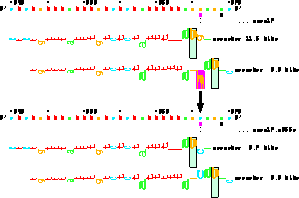This press release contains a glossary and pointers to background materials for Dr. Rogan's and Dr. Schneider's presentations. See https://alum.mit.edu for more information.
![]() Information theory: a mathematical theory of symbols
and states and how they can be made distinct in the presence of noise. It
was invented by Claude Shannon in 1948. A primer on the topic is available
from
https://alum.mit.edu/www/toms/paper/primer/index.html
Information theory: a mathematical theory of symbols
and states and how they can be made distinct in the presence of noise. It
was invented by Claude Shannon in 1948. A primer on the topic is available
from
https://alum.mit.edu/www/toms/paper/primer/index.html
![]() Molecular biology: the study of living systems at the
molecular level.
Molecular biology: the study of living systems at the
molecular level.
![]() Molecular information theory: the study of living
systems at the molecular level by using information theory.
Molecular information theory: the study of living
systems at the molecular level by using information theory.

![]() Sequence logo: a graphical representation of the patterns at a set of
genetic binding sites. The human donor splice junction sequence logo is
shown here. See
https://alum.mit.edu/www/toms/sequencelogo.html for more examples.
Sequence logo: a graphical representation of the patterns at a set of
genetic binding sites. The human donor splice junction sequence logo is
shown here. See
https://alum.mit.edu/www/toms/sequencelogo.html for more examples.

![]() Sequence walker: a graphical representation of a
single genetic binding site. The example given here shows the effect of a
mutation that causes blindness, found by R. Allikmets and M. Dean. See
https://alum.mit.edu/www/toms/ ~toms/walker/movie/index.html
Sequence walker: a graphical representation of a
single genetic binding site. The example given here shows the effect of a
mutation that causes blindness, found by R. Allikmets and M. Dean. See
https://alum.mit.edu/www/toms/ ~toms/walker/movie/index.html

![]() Gumball machines: represent the packing of spheres in
a high dimensional space. In communications theory, the number of distinct
messages that can be sent over a communications channel depends on the power,
the interfering noise and the bandwidth used. This channel capacity can be
determined by counting the number of possible messages. Each gumball
represents a different message, and their relative positions is the coding.
In molecular information theory, each gumball represents a different state of
a molecule. See
https://alum.mit.edu/www/toms/paper/ccmm and
https://alum.mit.edu/www/toms/paper/edmm
Gumball machines: represent the packing of spheres in
a high dimensional space. In communications theory, the number of distinct
messages that can be sent over a communications channel depends on the power,
the interfering noise and the bandwidth used. This channel capacity can be
determined by counting the number of possible messages. Each gumball
represents a different message, and their relative positions is the coding.
In molecular information theory, each gumball represents a different state of
a molecule. See
https://alum.mit.edu/www/toms/paper/ccmm and
https://alum.mit.edu/www/toms/paper/edmm


Schneider Lab.
origin: 1997 December 19
updated: 1998 January 7

U.S. Department of Health and Human Services
|
|
|
USA.gov
|
Policies
|
Viewing Files
|
Accessibility
|
FOIA